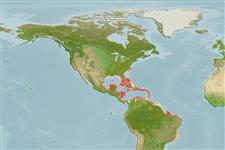Preferred temperature (Ref.
123201): 24.4 - 28.2, mean 27.3 °C (based on 713 cells).
Phylogenetic diversity index (Ref.
82804): PD
50 = 0.5000 [Uniqueness, from 0.5 = low to 2.0 = high].
Bayesian length-weight: a=0.00912 (0.00581 - 0.01432), b=3.07 (2.94 - 3.20), in cm total length, based on LWR estimates for this species & Genus-body shape (Ref.
93245).
Nivel trófico (Ref.
69278): 3.8 ±0.1 se; based on diet studies.
Resiliencia (Ref.
120179): Medio, población duplicada en un tiempo mínimo de 1.4-4.4 años (Preliminary K or Fecundity.).
Fishing Vulnerability (Ref.
59153): Low vulnerability (25 of 100).
Nutrients (Ref.
124155): Calcium = 49.8 [30.1, 82.1] mg/100g; Iron = 0.566 [0.328, 1.026] mg/100g; Protein = 18.8 [15.9, 21.0] %; Omega3 = 0.13 [0.09, 0.20] g/100g; Selenium = 23.2 [14.0, 42.4] μg/100g; VitaminA = 115 [35, 409] μg/100g; Zinc = 1.3 [0.9, 2.0] mg/100g (wet weight);
